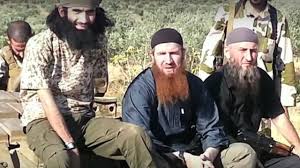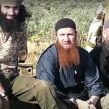
Chechen Militants in Syria Make Key Gains in Syria Fighting
Publication: Eurasia Daily Monitor Volume: 11 Issue: 64
By:

The actions of Chechens in Syria—repeatedly examined in this publication over the past two years—is a complex issue, which involves, in particular, the symbiosis of North Caucasian perseverance and Middle Eastern Islamic radicalism. This emerging phenomenon is more dangerous to Russia than the current problems it faces in the North Caucasus.
The latest major development on this topic has been the intense worldwide information campaign detailing the alleged execution of 80 Armenians in the town of Kessab near Latakia, Syria. Notably, Russia’s Ministry of Foreign Affairs called on the world community to react urgently to the events in the area historically settled by Armenians (www.vz.ru/news/2014/4/1/680037.html). The leader of Chechnya, Ramzan Kadyrov, also did not shy away from becoming involved and released a statement stating that those who carried out the killings were terrorists who have nothing in common with Islam and asked why the United States and Europe were silent about the incident (www.novayagazeta-ug.ru/news/u2689/2014/04/01/49682).
Moscow has gone to great effort to help spread the news about the terrible video recording of the execution being carried out by Islamists (https://www.youtube.com/watch?v=7oXbTIok7d8). Emphasizing the Armenian ethnic identity of Kessab’s residents, Moscow tried to prove that the West is pandering to extremists in Syria. The video shows people being shot while they are down on their knees. The execution is accompanied by shouts from the Islamists. First, the campaign organizers show the targeting of Christians—Armenians in this case—to the world. Next, the ethnic origin of the victims produces an outcry in Russia and in the countries of the former Soviet Union. Finally, the campaign attempts to implicate Turkey, forcing Ankara to justify its assistance to Syrian militants who murder Armenians.
In reality, however, this brutal video has nothing to do with the town of Kessab or its Armenian residents. Anyone who follows the situation in Syria knows that this video was posted on YouTube several months prior to the seizure of Kessab. The video was not made in Kessab, because it has a clear location and timing—the Al Kindi Hospital in the city of Aleppo in December 2013 (https://www.liveleak.com/view?i=809_1395163651). Additionally, the video was uploaded several days prior to the capture of Kessab by the anti-government forces.
This does not make the life of residents of Kessab any easier, of course, since they were still forced to leave their town, which they had been defending together with Bashar al-Assad’s army, making them possible targets of retribution by the Syrian jihadists. Still, residents of the town did not report any executions of Armenians by the militants (https://news.am/rus/news/201845.html). While they spoke of “genocide,” the Armenians from Kessab meant that they had lost their belongings and were forced to abandon their homes. A letter written on behalf of the residents of Kessab says that the town was attacked by al-Qaeda and al-Nusra (https://piter.tv/event/genocid_armyan_v_kesabe_video/). The authors of the letter did not even know that al-Nusra is synonymous with al-Qaeda. They also did not know that their city was stormed and captured by Chechen units.
Why did the jihadists storm this city, which is located near the border with Turkey? According to French sources, a Russian radar was stationed there 1,300 meters above sea level (https://www.tert.am/ru/news/2012/06/15/russia-kessab/). This contradicts a statement by the Russian foreign ministry that there were no military installations in the area (https://www.vz.ru/news/2014/4/1/680037.html). The Russians used this radar to monitor the Turkish side of the border. Further, Aram I, the spiritual leader of the Holy See of Cilicia of the Armenian Apostolic Orthodox Church, proposed demilitarizing the Kessab area in Syria, pointing to possible actions by Turkey (https://www.arminfo.am/index.cfm?objectid=8009B8C0-B670-11E3-873F0EB7C0D21663). If the area were not militarized, as the Russian foreign ministry asserts, then there would be no reason to demilitarize it.
Another peculiar aspect concerning this incident is the reticence of Russian officials to discuss the identities of those who captured Kessab and the strategically important heights around it. The operation was carried out not by nameless units of al-Nusra or the Islamic State of Iraq and Sham, but specifically by Chechen groups. Abu Musa ash-Shishani, the Chechen commander of Ansar ash-Sham, led the liberation of the province of Latakia. Also another Chechen group, Jundu ash-Sham, led by Emir Muslim, and the group Jaish al-Muhajireen wal-Ansar, led by Emir Salautdin, participated in the assault and killed Brigadier General Yusef Abbas, who was a close associate of Maher al-Assad (https://khilafa.org/?p=2989).
Thus, the bulk of Chechen forces in Syria, with the exception of the Islamic State of Iraq and Sham, which is led by Emir Umar Shishani, participated in the capture of Kessab and the adjacent coastal area. Thus, the information about al-Qaeda taking Kessab is not true. None of the three commanders who stormed Kessab—Emir Muslim, Emir Abu-Musa or Emir Salautdin—have pledged allegiance to the Islamic State of Iraq and Sham or al-Nusra. Apparently trying to make its disinformation look credible, Moscow consciously dropped the ethnic origins of those who attacked Kessab. The Russian government must have thought that this would be an unwanted advertisement for the militants of the North Caucasus. Given the fact that there are reportedly some units of Crimean Tatars fighting alongside the Chechens, Moscow did not want to touch on the sensitivities of its own citizens, who may start worrying that Crimea could become a new hotbed of tensions.
Thus, Russia attempted to conceal Chechen participation in the operations against the town of Kessab in order to prevent that operation from becoming a source of inspiration for the North Caucasian armed resistance. However, news in Russia is no longer delivered through the newspapers Pravda and Krasnaya Zvezda, as it was in the 20th century. The Internet makes it possible to overcome the obstacles Moscow tries to use to impede access to truthful information.




